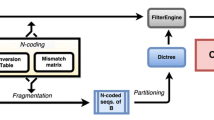Abstract
In this paper, we propose the incremental group testing model for the gap closing problem, which assumes that we can tell the difference between the outcome of testing a subset S, and the outcome of testing S ∪ {x}. We also give improvements over currently best results in literature for some other models.
Similar content being viewed by others
References
R. Beigel, N. Alon, S. Kasif, M.S. Apaydin, and L. Fortnow, “An optimal procedure for gap closing in whole genome shotgun sequencing,” in Proceedings of the Fifth Annual International Conference on Computational Biology, Montreal, Quebec, Canada, 2001, pp. 22–30.
L.J. Burgart, R.A. Robinson, M.J. Heller, W.W. Wilke, O.K. Iakoubova, and J.C. Cheville, “Multiplex polymerase chain reaction,” Mod. Pathol., vol. 5, pp. 320–323, 1992.
P. Damaschke, “A tight upper bound for group testing in graphs,” Discrete Applied Math., vol. 48, pp. 101–109, 1994.
D.-Z. Du and F.K. Hwang, Combinatorial Group Testing and its Applications, Series on Applied Mathematics, 2nd ed. World Scientific: Singapore, 2000.
V. Grebinski and G. Kucherov, “Reconstructing a Hamiltonian cycle by querying the graph: Application to DNA physical mapping,” Discrete Applied Math., vol. 88, pp. 147–165, 1998.
V. Grebinski and G. Kucherov, “Optimal reconstruction of graphs under the additive model,” Algorithmica, vol. 28, pp. 104–124, 2000.
M. Hell, Combinatorial Theory, 2nd ed. Wiler Interscience: New York, 1996.
P. Johann, “Agroup testing problem for graphs with several defective edges,” Discrete Applied Math., vol. 117, pp. 99–108, 2002.
B. Lindstrom, “On a combinatorial problem in number theory,” Canad. Math. Bull., vol. 8, pp. 261–265, 1965.
B. Lindstrom, “Determination of two vectors from the sum,” J. Combin. Thy., vol. A6, pp. 402–407, 1969.
J. Nagura, “On the interval containing at least one prime number,” Proc. Japan Acad., vol. 28, pp. 177–181, 1952.
A. Sorokin, A. Lapidus, V. Capuano, N. Galleron, P. Pujic, and S.D. Ehrlich, “A new approach using multiplex long accurate PCR and yeast artifical chromosomes for bacterial chromosome mapping and sequencing,” Genome Res., vol. 6, pp. 448–453, 1996.
G. Tenenbaum, The Prime Numbers and Their Distribution. AMS: USA, 2000.
H. Tettelin, D. Radune, S. Kasif, H. Khouri, and S.L. Salzberg, “Optimized multiplex PCR: Efficiently closing a whole-genome shotgun sequencing project,” Genomics., vol. 62, pp. 500–507, 1996.
Author information
Authors and Affiliations
Rights and permissions
About this article
Cite this article
Hwang, F.K., Lin, WD. The Incremental Group Testing Model for Gap Closing in Sequencing Long Molecules. Journal of Combinatorial Optimization 7, 327–337 (2003). https://doi.org/10.1023/B:JOCO.0000017381.11696.c6
Issue Date:
DOI: https://doi.org/10.1023/B:JOCO.0000017381.11696.c6




